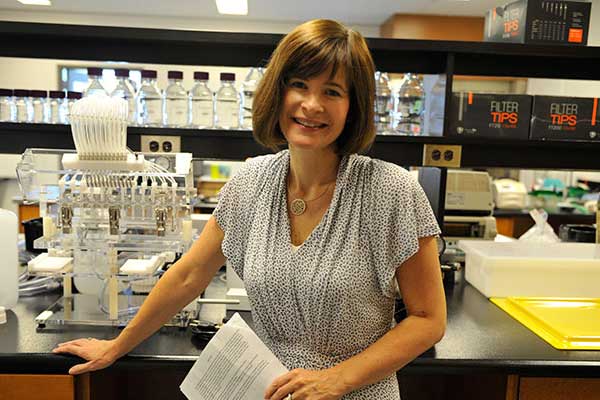
Marijuana in medicine: can experts create pain relief without a high?
Published: February 16, 2016
As the debate over medical marijuana continues, researchers at the University of Toronto are learning how to activate the unique painkilling properties of cannabis without the dependence or the high. Could an entirely new type of painkiller be around the corner?
Writer Heidi Singer of the Faculty of Medicine discussed this heady prospect with Professor Ruth Ross, chair of the department of pharmacology and toxicology and a prominent researcher in this field.
What’s the advantage of cannabis as a painkiller?
People have known for a long time that cannabis relieves pain, but we haven’t known why. In the past 15 years, we’ve learned that cannabis and THC, the chemical that powers marijuana, interact with the CB-1 receptor, which plays a major role in blocking pain.
It’s part of a cluster of receptors that make up the endocannibinoid system, which is very involved in mood, memory, appetite, pleasure and pain. This is different than the system that opioids [like OxyContin or codeine] work on. For example, it’s located in different parts of the nervous system, which means that cannabinoids are particularly effective in some types of pain where opioids are sometimes less effective — like nerve pain.
The challenge has been taking advantage of that pain relief system but minimizing the psychotropic side effects. If you need to take a painkiller frequently for a chronic condition, these are a problem: cannabis affects short term memory and makes it harder to concentrate.
The other challenge with cannabis is its complexity. Most medicines consist of just one chemical compound, but natural substances contain a lot more – at least 60 in the case of cannabis. That can be a good thing, but it means we need a lot more research to understand the benefits versus the drawbacks of this substance as a drug.
What does your research reveal about cannabis as a medicine?
I was part of a group of researchers that discovered a new way of targeting this CB-1 receptor. We discovered an ‘allosteric binding pocket’ on the receptor. This discovery allowed us to enhance the analgesic effect of the endocannabinoid at pain receptors in the endocannibinoid system. We developed a molecule that killed pain without causing a high – it’s call a ‘positive allosteric modulator’ or PAM. So we proved the concept, but now we need to make better versions of the molecule that could one day be made into a new drug. If all goes well, we’ll probably have a drug in five to ten years.
How often does an entirely new class of painkiller come along?
It’s rare, and we need new ones. Opioids have problems with dependence, addiction and tolerance – the increasing need for more. Non-steroidal anti-inflammatories [like Ibuprofen] have side effects like gastrointestinal distress. And medical marijuana has psychoactive properties. It could be that the answer is a combination of painkillers that target different pain systems. There’s evidence that combining ultra-low doses of cannabis and opioids would be effective, without the addiction or tolerance issues. That would be a whole new type of treatment.
In January, six participants in a French drug trial suffered unexpected side effects, and one was left brain dead, from a drug derived from cannabis. What’s your take on this disaster?
A number of companies were making this class of drug for pain relief, and one even has a similar drug already in phase II trials [meaning it passed safety tests already, which occur in phase 1 trials]. For that reason, this might simply have been a bad batch of drug, contaminated with something horrible. Or the particular compound they tested has some other problem with it. It’s a terrible tragedy.
That class of drugs works differently than ours. They developed a compound that allows certain molecules, the endocannabinoids, to build up in your body. These compounds inhibit the enzyme that breaks down endocannabinoid (called FAAH). A number of companies are taking this approach. Our compound acts differently – it targets the receptor specifically implicated in pain relief – the CB1 receptor and magnifies the pain-relieving effect of the cannabinoids.
From what I can gather the companies were planning to test their compounds, the FAAH inhibitors, for anxiety, which is another exciting area for research into the endocannibinoid system. Researchers can explore what happens in various illnesses when you tune up the endocannibinoid system. The system can be enhanced by either preventing the breakdown of the endocannabinoids or by tuning up the receptor with a positive allosteric modulator – like our compound. The hope is that we can develop new, safe and effective medicines for challenging illnesses.



